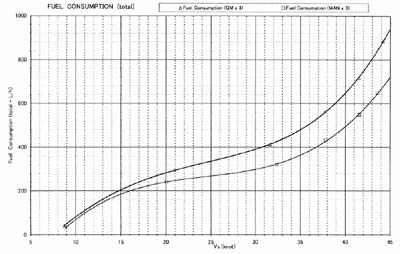|
<Table 6-1>
|
(拡大画面:96KB)
|
 |
This table shows horsepower and speed. At the 40 KT the same speed is achieved at 180 ps less horsepower. Even with an economical speed of 32 KT, the horsepower is 100 Ps less. This is a speed for the main engine at 1/2 load.
<Table 6-2>
|
(拡大画面:97KB)
|
 |
This is fuel consumption. It has also been reduced; in one hour, it is 150 liters at 40 KT and 100 liters at 32 KT.
<Table 6-3>
|
(拡大画面:111KB)
|
 |
This is a comparison of the cruising range. Cruising range is 370 nautical miles at 30 KT, increasing by 90 nautical miles from 280 nautical miles. So you can see that for high speed and planing boats, both the ship type and weight have a huge impact on speed. Other than the weight of the hull, industrial parts for ships such as the main engine must be as light and strong as important partners of high-speed ship construction.
3. Fishery Patrol Boats
Currently, there are 64 aluminum fishery patrol boats in operation throughout Japan. Because illegal ships are becoming faster and patrol areas are expanding, aluminum boats meet these high speed and large-size requirements. Recently, we see more and more high-speed boats exceeding 40 tons. When you include survey ships, practice ships, and training ships, more than 80 aluminum ships are currently on active.
4. Customs Ships
<Table 7>
Table of Customs Boats (After 1997)
| Year of Construction |
Delivered To |
Vessel Name |
Port |
Total Tonnage |
Total Length (m) |
Max Speed (Kt) |
Cruising Speed |
Date of Delivery |
Remarks |
| FY 1997 |
Nagasaki Customhouse |
Nansei |
Kagoshima |
130 |
37.4
(Light alloy) |
36 |
32.29 |
H10-3 |
|
| FY 1998 |
Kobe Customhouse |
Kobe |
Kobe |
69 |
27.3
(Light alloy) |
43.5 |
37.8 |
H11-3 |
|
| FY 1999 |
Osaka Customhouse |
Tateyama |
Toyama |
50 |
25.0
(Light alloy) |
32 |
30 |
H11-10 |
|
| Moji Customhouse |
Genkai |
Moji |
69 |
26.4
(Light alloy) |
34.1 |
32.4 |
H11-10 |
|
| Yokohama Customhouse |
Tsubasa |
Yokohama |
125 |
36.4
(Light alloy) |
34 |
32 |
H12-3 |
|
| FY 2000 |
Nagasaki Customhouse |
Saikai |
Nagasaki |
60 |
26.8
(Light alloy) |
32.2 |
31 |
H13-3 |
|
| Nagoya Customhouse |
Hagoromo |
Shimizu |
68 |
28.1
(Light alloy) |
44.2 |
37.8 |
H13-3 |
|
| FY 2001 |
Moji Customhouse |
Asahi |
Tokuyama |
24 |
17.9
(Light alloy) |
33 |
31 |
H13-11 |
|
| Moji Customhouse |
Bibiki |
Moji |
31 |
19
(Light alloy) |
39.7 |
35 |
H14-3 |
|
| Osaka Customhouse |
Oomine |
Osaka |
58 |
27.3
(Light alloy) |
45.2 |
42.8 |
H14-6 |
|
| FY 2002 |
Yokohama Customhouse |
Shiokaze |
Shiogama |
68 |
26.5
(Light alloy) |
32 |
30.28 |
H15-3 |
|
| Nagoya Customhouse |
Fuji |
Nagoya |
68 |
26.5
(Light alloy) |
43.7 |
38.3 |
H15-3 |
|
|
We have been building customs ships since 1997. Again with the increasing demands for large-size and high-speed vessels, high-tensile steel ships are gradually being replaced by aluminum ships.
5. High-Speed Passenger Ships
<Table 8-1>
Gross Tonnage and Number of Boats by Type
|
(拡大画面:68KB)
|
 |
|
Gross Tonnage and Number of Boats by Type
1. The above table shows aggregates of figures in the vessel type and material columns of the vessels in service by sea route table.
Data of vessels not in service, including reserve ship, are not included.
2. If the vessel enters two or more services, only information concerning the major route is included to avoid an overlap.
3. If an automobile transport is placed in commission for purposes other than transporting cars, it is regarded as a passenger or cargo ship.
4. Vessels counted repeatedly among local offices arc excluded in the national total.
|
Looking at passenger ships, there are very few light alloy ships. But for high-speed ships, light alloy ships are increasing year by year.
<Table 8-2>
High Speed Vessels in Service
|
(拡大画面:41KB)
|
 |
Note 1: |
The above table is compiled based on “High Speed
Vessels Service” issued by Passenger Boats of Japan. |
Note 2: |
Recored of survey results of high speed passenger
ships in service as of November 1 in each region. |
|
Note 3:
|
Vessels meeting the following conditions are considered
to be high speed passenger ships |
|
|
1. Vessel length (total length): Below 50 m
|
|
|
2. Service speed: Above 22 knots
|
|
|
3. Navigation area: Excludes far seas
|
|
With high-speed ships for example, 68% are aluminum and only a few, 2%, are made of steel.
This <Photo 3> is Cobalt Arrow 5, an aluminum high-speed ship cruising West Izu. This is compared with a vessel with a hull made of high tensile steel and superstructure made of aluminum.
<Photo 3>
|